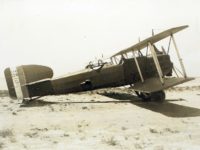The Breguet XIV was a French multi-purpose aircraft that was used both as a reconnaissance aircraft and as a bomber and was used until well after the First World War.
Development and construction:
The French company Société Anonyme des Ateliers d’Aviation Louis Breguet was founded in Douai in 1911 by the entrepreneur Louis Charles Breguet and initially only produced seaplanes at the Villacoublay production site. It was not until mid-1916, while the First World War was still ongoing, that the development of a modern multi-purpose aircraft began, which should be technically equivalent to German aircraft.
The result was the prototype, initially known as the Breguet AV Type XIV, which was very robust thanks to its large box-shaped fuselage with rectangular wings and a basic structure made of steel, dural and wood.
The reconnaissance variant A2, called Breguet XIV A2 after its introduction in the French Air Force, also received transparent windows on the observer's cockpit windows in addition to the camera and radio. The bomber variant produced a little later, however, received additional landing flaps.
Various engines were used for the drive, including the 300hp Fiat A.12bis, the 400hp Liberty and most often the 400hp Renault 12K.
The first flight of the prototype took place on November 21, 1916, and a short time later it was presented to the French Air Force.
Use in the First World War:
The performance of the Breguet AV Type XIV prototypes convinced the command of the French Air Force, so that on March 16, 1917 the first 150 copies were ordered to be used as reconnaissance aircraft on the Western Front.
This initial order was quickly supplemented by further orders, whereby in addition to the reconnaissance variant, a version as a bomber was developed and built at the same time. The first row of single-seat bombers were designated as the Breguet XIV B1, but were only produced in small numbers. The two-seat variant Breguet XIV B2, on the other hand, was ordered and produced in larger numbers.
Later in the war, the Roman numerals were replaced and exchanged for 14.
Before the end of the First World War, a medical variant, the Breguet 14S, was developed and built, but only in small numbers. The medical variant was later expanded and referred to as the Breguet 14T and 14Tbis. By December 1918, shortly after the end of the war, a total of 5.300 aircraft of the various variants were produced.
After the war, the Breguet 14 aircraft were sold to other air forces, so that they were ultimately used in Belgium, Brazil, Denmark, Greece, Yugoslavia, Poland, Portugal, Romania, Siam, Spain, Czechoslovakia and the USA. In total, in addition to the 5.300 aircraft already produced, another 2.500 were added until production was finally discontinued in 1928.
Technical specifications:
| Designation: | Breguet XIV |
| Country: | France |
| Type: | Reconnaissance plane Bomber Ambulance aircraft |
| Length: | 8,87 meters |
| Span: | 14,36 meters |
| Height: | 3,30 meters |
| Weight: | 1.030 kilograms empty |
| Crew: | Max. 2 |
| Engine: | a water-cooled in-line engine Renault 12K with 400 HP |
| Maximum speed: | 184 kilometers per hour |
| Range: | Max. 3 hours of flight |
| Armament: | 3 machine guns 7,7 mm 40 kilograms of bombs (4 × 10 kg) |
This post is also available in:
 Deutsch (German)
Deutsch (German)  Français (French)
Français (French)  Italiano (Italian)
Italiano (Italian)  简体中文 (Chinese (Simplified))
简体中文 (Chinese (Simplified))  Русский (Russian)
Русский (Russian)  Español (Spanish)
Español (Spanish)  العربية (Arabic)
العربية (Arabic)
















